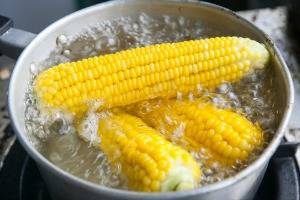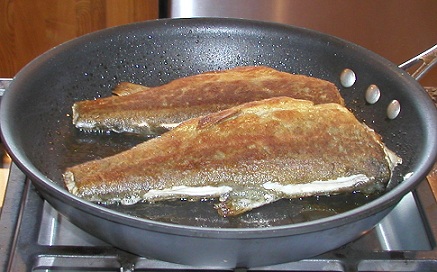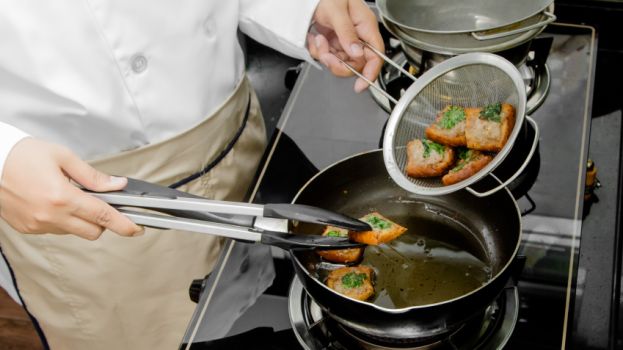Reason for cooking food
Food is any liquid or solid which, when consumed, should provide after absorption, nutrients to facilitate growth, repair, and protection from a range of unhealthy conditions. while liquids such as water and fruit juices and some fruit and vegetables can be consumed in the natural form without being subjected to heat, unfortunately, this is not so for all foods.
Cooking is necessary for a number of reasons:
- To destroy or inactive micro organisms in and on the surface of the food, thus making food safe to eat.
- To improve the flavor. For example, roasting meat develops extractives which enhance the flavor.
- To preserve food from spoilage, which is a natural process.
- To improve the digestibility of staples, some foods from animals and legumes.
- To maximize nutritive value.
- To destroy natural toxins in foods.
- To provide variety in the diet. For example, fish can be steamed, baked, fried, grilled or poached.
- To make the food more appetizing and attractive.
Methods of Cooking
Air water, steam and fat, or combinations of them, are used for transferring heat to the food. The methods of cooking food are classified according to how the heat is transferred to the food. the classification used is moist heat, dry heat, or combination of methods.
Moist heat cooking methods
Boiling
- Medium– water or other liquid
- Place/Equipment– inside pan/stove
- Type of heat transfer– conduction
- Benefits– Simple, moist method; water is easily available; requires little attention; heat transfer by conduction is quick and efficient.
- Possible problems– Soluble nutrients may be lost in the liquid; some flavor is lost from meat; food may look unattractive.
- Suitable foods– Starchy roots, e.g. dasheen, yams, cereals, legumes.

Parboiling
- Medium– water or other liquid
- Place/equipment– inside pan/stove
- Type of heat transfer– Conduction
- Benefits– softens the outside of foods in preparation for baking/grilling.
- Possible problems– can be overdone if not timed properly
- Suitable foods– potatoes, whole chicken legs
Poaching
- Medium– water or other liquid
- Place/equipment– inside a frying pan or a saucepan with a little liquid/stove or oven.
- Type of heat transfer– convection and conduction
- Benefits– shrinkage is reduced; takes 1/3 less time than roasting.
- Possible problems– foods may be bland and unattractive.
- Suitable foods– eggs, fish

Simmering
- Medium– water or other liquid
- Place/equipment– inside pan/stove
- Type of heat transfer– conduction
- Benefits– Long, slow, moist method of cooking; economical of fuel; cooking at 185°F (85°C) softens food; keeps food whole
- Possible problems– takes time
- Suitable foods– meats, sauces

Steaming
- Medium– steam
- Place/equipment– in a steamer or over a pan of boiling water/stove
- Type of heat transfer– convection and conduction
- Benefits– minimal loss of nutrients from leaching as food does not come into contact with water; food easy to digest; economical of fuel; requires little attention.
- Possible problems– process may be lengthy; destruction of vitamin C by heat may occur.
- Suitable foods– vegetables, puddings, fish

Pressure Cooking
- Medium– steam under pressure
- Place/equipment– inside pressure cooker
- Type of heat transfer– conduction and convection
- Benefits– very quick method using super-heated steam; economical of fuel; reduced nutrient loss by leaching;tenderizes tough cuts of meat; suitable for cooking whole meals.
- Possible problems– equipment is expensive to purchase; careful timing is necessary to prevent overcooking.
- Suitable foods- trotters, cow heel, dried peas jam making

Stewing
- Medium– liquid
- Places/equipment– in a saucepan with a little liquid/stove
- Type of heat transfer– convection and conduction
- Benefits– tenderizes tough cuts of meats; minimal nutrient loss as liquid is served with the food; food retains flavor; low heat is required so is economical of fuel; can be used for cooking one pot meals.
- Possible Problems– a long, slow method of cooking; provides little variation in texture and consistency.
- Possible Foods– tougher cuts of meat, e.g. flank, oxtail and cow heel, fruits

Dry heat cooking methods
Baking
- Medium– air
- Place/equipment– inside oven
- Type of heat transfer– radiant heat
- Benefits– no loss of soluble nutrients; food keeps its shape; has crisp brown surface
- Possible problem– Food may dry out; can be wasteful of fuel if maximum use is not made of oven.
- Suitable foods– cakes, pastry, breads

Roasting
- Medium- air
- Place/equipment- inside oven with addition of fat
- Type of heat transfer-radiant heat
- Benefits- little attention is required; tenderizes suitable cuts of meat; food develops full flavor; economical of fuel if oven is used to full capacity.
- Possible problems- moisture loss is high due to high temperature; meat may shrink visibly from loss of moisture and denaturing of protein.
- Suitable foods- joints of meat, e.g. leg or shoulder of lamb or pork; topside of beef, etc. potatoes

Barbecuing/grilling/broiling
- Medium– air
- Place/equipment– overhead broiler, rotisserie, on a grill pan or in toaster.
- Type of heat transfer– radiant heat
- Benefits– food is quickly cooked, has good flavor and color. healthy method as fat is drained from meat.
- Possible problems– Tender cuts must be used and these tend to be more expensive; requires careful timing to prevent burning; charring which occurs is now linked to carcinogens.
- Suitable foods– tender cuts of meat, e.g. steaks, chops, burgers, sausages, poultry joints, e.g. drumsticks, chicken wings

Frying
Deep fat
- Medium– fat
- Place/equipment– deep fryer on stove or electric frying pan (food is totally immersed in fat)
- Type of heat transfer– conduction
- Benefits– rapid method of cooking; food browns evenly; is crisps; energy is increased by the use of fat.
- Possible problems– fried food is not easily digested; requires oil to fill half the pan.
- Suitable foods– fish portions, small poultry joints, potato chips, fish cakes, donuts.

Dry
- Medium– fat
- Place/equipment– inside frying pan on stove, no additional fat added
- Type of heat transfer– conduction

Shallow fat
- Medium– fat
- Place/equipment– inside frying pan on stove, a little fat added
- Type of heat transfer– conduction

Stir frying/ sautéing/ pan frying
- Medium- fat
- Place/equipment- Inside frying or wok/stove
- Type of heat transfer- conduction
- Benefits- Uses about 1 tbsp oil in the wok; fast, healthy method; few nutrients are lost; food retains crispness and is well flavored; economical of fuel.
- Possible problems- takes time to prepare food for this method.
- Suitable foods- small meat/fish portions, vegetables

Combination cooking methods
Braising
- Medium– fat or liquid
- Place/equipment– browned on stove w/wo fat simmering/stewing on stove top or in oven.
- Type of heat transfer– conduction and convection

Fricasseeing/pot roasting
- Medium- Fat or liquid
- Place/equipment- For pieces of meat w/wo fat on stove top or oven
- Type of heat transfer- conduction and convection

Principles underlying methods of cooking
Boiling: The liquid is usually heated to boiling point and kept bubbling evenly and quickly.
Parboiling: This is part cooking of food by boiling for a short period. The cooking is completed by another method.
Simmering: Heating at a temperature just below boiling point. Few bubbles are seen on the surface.
Baking: Surface of food is cooked by exposure to the dry heat of convection currents in the air surrounding the food and also by conduction of heat from the container to the food. The inside of the food is cooked by conduction of heat from the surface.
Broiling: Cooking over or under direct heat as in a broiler or over live coals.
Roasting: Like baking. Food is cooked by convection currents and by conduction where the food touches the pan.
Barbecuing: Barbecuing is cooked food- beef, chicken, sausages, etc.- over hot coals. When a grill is used, it is called grilling. Direct radiant energy from coals, gas or electricity cooks the food.
Steaming: Heat is transferred from the steam to the food. Food is said to be steamed when it is cooked in water vapor above water or in a water-less cooker (in which cooking is done in the presence of a small amount of liquid and the steam it produces). Wrapping food in aluminium foil before cooking is another method of steaming.
Pressure cooking: A pressure cooker, tightly sealed, is used for pressure cooking, where the food is cooked with steamed under pressure. The increase in pressure increases the boiling point of water to 250°F (121°C) and this increased heat cooks the food even faster.
Frying: Fat is the medium for all different types of frying listed above. the difference is in the amount used. For sautéing and stir-frying, heat is transferred by conduction. For shallow and deep fat frying conduction through contact with the heated pan as well as convection currents through the fat help to cook the food.
Braising and fricasseeing: These are examples of a combination of cooking methods using fat and water. The surface of the food is browned in a small quantity of fat, then the food is slowly cooked in liquid or juices in a covered utensil. When a large piece of meat is cooked in this manner, this method is called pot roasting.
Nutritional effects of cooking- the losses
While the use of heat on food offers significant benefits to consumers, we need to be aware of the down side of the process. When we eat fresh fruits and vegetables without cooking them, we get much nutritional value than when we cook them. Nutrient losses occur during preparation and cooking. These are related to exposure to oxygen and light, how susceptible the food is to heat and pH changes.
A major loss that occur quite often is that of water-soluble vitamin B and C throwing away excessive water used in boiling vegetables. Soaking and washing meats cause loss of some of the water-soluble vitamins. Browning meat by high temperatures also causes destruction of these vitamins. Carotene and vitamin A can also be destroyed by oxidation, speeded up by heat and light.
Washing rice before cooking is an action that destroys some of the B vitamins especially in enriched rice.
Reference
Dyer, R, Maynard N. (2005). C-SEC Home Economics And Beyond Food And Nutrition. Macmillan Education.

